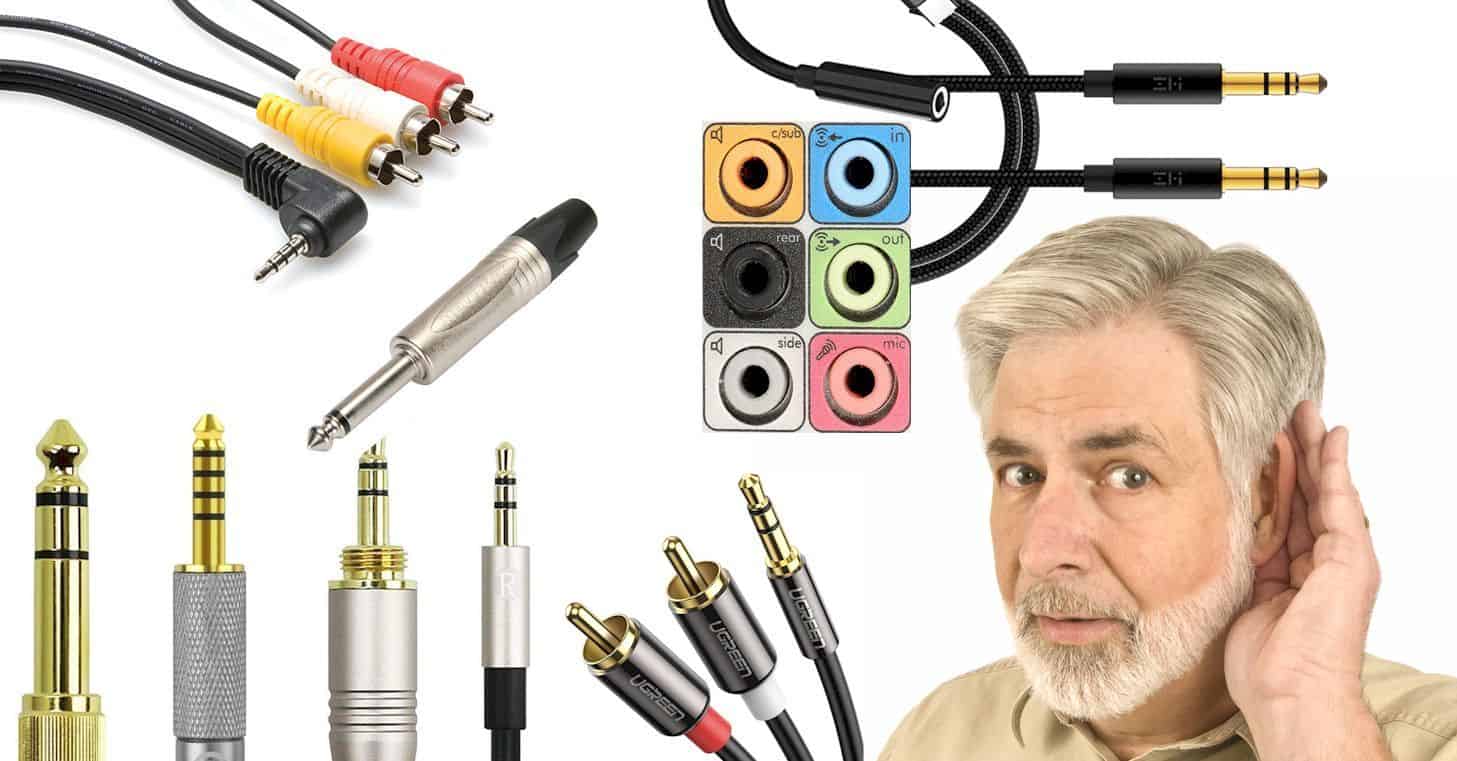There are so many different audio connector types as there are different audio devices and equipment. It’s easy to make a mistake using a device that cannot connect to your receiver or audio equipment if you’re not careful. So to help you avoid costly errors, here is a list of all the most common analog and digital types of audio connectors and adapters.
Contents
What are audio connectors?
When you say “audio connector” it refers to any kind of component that connects a wire or a cable to another device, different types of audio cables or wire. An audio component may be classified as male or female or as input or output. When it comes to an audio connector, this is the end of the cable which will connect to an audio port or audio jack.
Audio connectors come in different designs, shapes, and forms. Some can be plugged easily into a corresponding audio port while some come with locking mechanisms to secure the connection. Meanwhile, an audio jack is any kind of port or opening with a corresponding type of connector. A jack is mostly always fixed and is usually female. The part that connects to a jack or port is a plug. This is mostly male and the most common one is a 3.5mm headphone connector. This plug is for earbuds and headphones to connect to smartphones, PCs, laptops, and digital music players.
An adapter is a type of audio device that can change signals from one kind of device to a compatible device. An adapter may link two different or incompatible devices and can also take the form of a connector to another connector.
Related: Methods of connecting your studio monitors to the audio interface
The Types of Audio Connectors
The 3.5 mm Stereo Mini Jack
One of the most common audio plug types is the 3.5 mm stereo mini-jack. It is also called a headphone jack as it is mostly found in headphones, headsets, and wired earbuds. Other names for this jack are stereo mini-jack, 1/8 – inch connector, or the 3.5 mm connector. The most popular kind of 3.5 mm connector has a TRS design or arrangement. TRS is short for Tip, Ring, Sleeve. This is a stereo connector as it comes with two contact points for speaker left and right outputs. Other similar connectors to the mini-jack are TS, TRRS, TRRRS, and the TRS stereo connector types.
The ¼ -inch/6.3 mm TRS connector plug
The TRS plug is mostly found in musical instruments and other professional audio equipment like keyboards, pianos, electric guitars, guitar amps, headphones, recording equipment, and other high fidelity equipment. Other names for the TRS plug are stereo ¼ - inch jack, the Balanced Jack, TRS Jack, and phone connector as this was once used by telephone operators to connect telephone calls.
The most common design for a ¼ - inch connector has a TRS design similar to a 3.5 mm jack however, it is larger and wider. Meanwhile, the 6.3 mm plug also has varying configurations, including TS and TRS with the latter very common in creating balanced stereo outputs.
Related: Daisy-chaining amplifiers
RCA or phono connector
Other very popular types of audio connection are the RCA or phono connectors. It is found in almost all stereo or audio equipment including high fidelity systems. RCA means Radio Corporation of America, which is the company that produced this type of connector way back in the 1940s. Other names for the RCA phono connector are RCA plugs, phono plugs, and Cinch plug, The name "phono" came to be as this type of connector was used to connect a phonograph to an amplifier.
The RCA is often white and red. The white is for the left channel while the red is for the right channel. The colors make it easier to connect two different devices or equipment, but you can interchange if you want. RCA connections take a 2-channel analog audio, composite signal to the left and right audio channels. RCA is for audio, but may be used to connect to mono audio as well.
Related: Mono and Stereo Comparison Guide
XLR audio connector
Although not as popular as RCA cables, the XLR connector is known by professional musicians and performers and is one of the preferred audio cable connector types. The XLR connector is found in professional audio equipment and was initially created by Cannon as a part of its Cannon X. This connector was revised and renamed Cannon XL and then, Cannon XLR. These are also called mic leads or Cannon leads.
The XLR audio connector comes with a 2 cm barrel with a male with 3 to 7 pins and a corresponding number of holes for females. But the most common one is the connector with 3 pins. This type of connector is used to create balanced audio and prevent interference or EMI. Most professionals prefer this connector to ordinary mic cables, monitor speakers, mixer cables, PA connections, professional audio equipment, and audio interfaces.
Optical digital audio TOSLINK connector
TOSLINK is Toshiba Link which is an optical digital audio interface. TOSLINK connectors were first developed for Toshiba CD players, but when audio equipment manufacturers saw their value, they adapted this connector to their devices.
The TOSLINK is also known as an optical digital audio connector with one side having a square tapered side while the other sides have angled edges. The TOSLINK sends signals from one device to another. This connector supports Lossless 2.0 PCM as well as compressed Dolby Digital formats. It cannot work with formats like DVD-A, HD audio, SACD, and Dolby TrueHD.
With the TOSLINK connector, digital audio is converted to light and is transferred through optical fiber cables. The length of a TOSLINK is only 5 meters despite being connected to fiber optic cables and other types of audio connections.
Banana Plug
The Banana Plug is also called speaker wire connectors. It can connect wires together like speaker wires to create an easy, tidy, well-kept wiring installation. Banana Plugs have a metallic pin in the middle which looks like a banana, hence the name of these audio connectors and adapters.
The Banana Plug has many advantages. One, it does not change the audio quality of your audio system. This plug helps keep your speaker connections tidy so it’s easy to use with different types of speaker systems. When using a Banana Plug for the first time, you need to spare time to prepare the plugs. But don’t worry, it only takes a few seconds to connect to your speaker or receiver.
Spade connectors or speaker pins
Compared to Banana Plugs, spade connectors or speaker pins have narrow and straight shapes. The designs of the two pins are almost similar but you should check your system’s terminals if your speakers come with spring-loaded terminals or a binding post terminal.
A spring terminal works by simply pressing the clip and installing bare speaker wires or pins. When the pins or wires are set, release the clip. This kind does not connect using spade connectors or banana plugs. Meanwhile, the binding post terminal comes with a screwed component that you need to unscrew to open up a hole and connect the bare speaker wires, banana plugs, speaker pins, or other connectors. Spade connectors are one of the most common audio connector types.
MMCX connectors
Another one of the least popular types of audio connectors is the MMCX is a micro-miniature coaxial. This cable is mostly found in IEMS and earbuds. These have a wide application for these devices. This connector is easy to use and fits many devices. It can be used with an MMCX jack and will allow 360 rotation. It is a small jack and thus makes it a good connector for IEMs and earbuds.
SpeakON
One of the new audio jack types or the connector is the SpeakON connector. This was created by Neutrix for professional musical instruments that work with inductive loads and very high currents. This connector can help prevent any damage from arcing when it is disconnected from a load.
The SpeakON comes in 2, 4, and 8-pole designs as the 2 and 4-pole are interchangeable from the same socket or port. You might say that you have never seen a SpeakON connector and this is because it is one of the newest connectors in the market.
Last Words
There are analog and digital audio connector types. Analog cables have continuous electrical signals that change voltages from positive to negative and may be balanced or unbalanced cables. RCA, TS, XLR, and TRS are analog cables. Meanwhile, digital cables transmit signals that can be used by computers. The most common digital cables are, TOSLINK, USB, MIDI, and digital coaxial cables. Find out what type of device you want to connect and the best connection that works for optimal audio output beforehand to avoid costly mistakes. Remember that great audio quality rests on the type of connector, cable, input and output device, and audio media. You must never settle for anything less.

Graduated with a Bachelor of Audio Engineering and Sound Production. He has worked with a number of studios as a Recording Engineer, with over 10 years of servicing experience in both re-recording mixing and sound editing.

